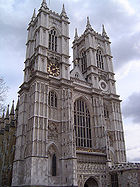
Diocese of Westminster
Encyclopedia

The Diocese was created from part of the Diocese of London, and comprised Westminster (which was raised to the dignity of a city
City status in the United Kingdom
City status in the United Kingdom is granted by the British monarch to a select group of communities. The holding of city status gives a settlement no special rights other than that of calling itself a "city". Nonetheless, this appellation carries its own prestige and, consequently, competitions...
), and the county of Middlesex
Middlesex
Middlesex is one of the historic counties of England and the second smallest by area. The low-lying county contained the wealthy and politically independent City of London on its southern boundary and was dominated by it from a very early time...
, with the exception of Fulham
Fulham
Fulham is an area of southwest London in the London Borough of Hammersmith and Fulham, SW6 located south west of Charing Cross. It lies on the left bank of the Thames, between Putney and Chelsea. The area is identified in the London Plan as one of 35 major centres in Greater London...
. Fulham was excluded as it was the site of Fulham Palace
Fulham Palace
Fulham Palace in Fulham, London , England, at one time the main residence of the Bishop of London, is of medieval origin. It was the country home of the Bishops of London from at least 11th century until 1975, when it was vacated...
, residence of the Bishop of London.
Westminster Abbey
Westminster Abbey
The Collegiate Church of St Peter at Westminster, popularly known as Westminster Abbey, is a large, mainly Gothic church, in the City of Westminster, London, United Kingdom, located just to the west of the Palace of Westminster. It is the traditional place of coronation and burial site for English,...
became the cathedral of Saint Peter and Thomas Thirlby
Thomas Thirlby
Thomas Thirlby was an English bishop. While he acquiesced in the Henrician schism, with its rejection in principle of the Roman papacy, he remained otherwise loyal to the doctrine of the Roman Catholic Church during the English Reformation....
became Bishop of Westminster.
Ten years later in 1550, on Thirlby's move to become Bishop of Norwich
Bishop of Norwich
The Bishop of Norwich is the Ordinary of the Church of England Diocese of Norwich in the Province of Canterbury.The diocese covers most of the County of Norfolk and part of Suffolk. The see is in the City of Norwich where the seat is located at the Cathedral Church of the Holy and Undivided...
, the diocese was merged back into the Diocese of London
Diocese of London
The Anglican Diocese of London forms part of the Province of Canterbury in England.Historically the diocese covered a large area north of the Thames and bordered the dioceses of Norwich and Lincoln to the north and west. The present diocese covers and 17 London boroughs, covering most of Greater...
. Westminster retained its city status. The cathedral became an abbey
Abbey
An abbey is a Catholic monastery or convent, under the authority of an Abbot or an Abbess, who serves as the spiritual father or mother of the community.The term can also refer to an establishment which has long ceased to function as an abbey,...
again six years later.
A Roman Catholic Archdiocese of Westminster was formed in 1850.

